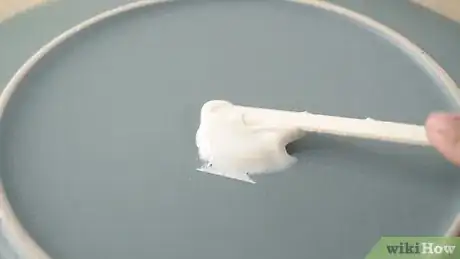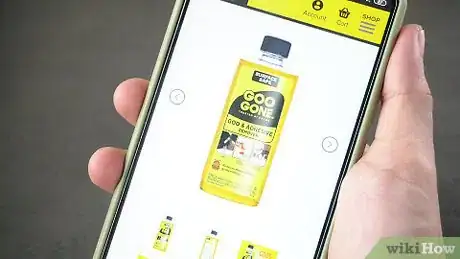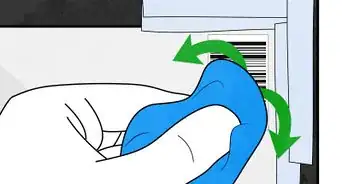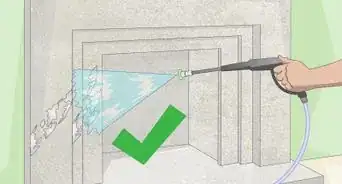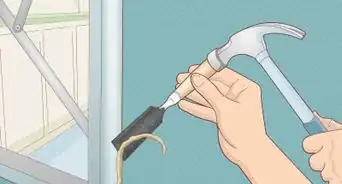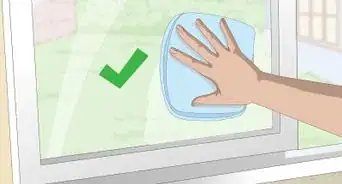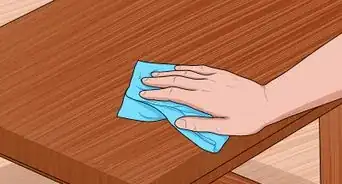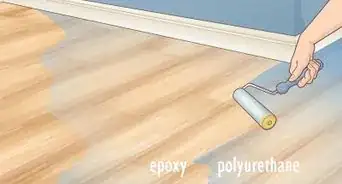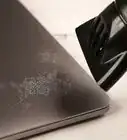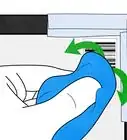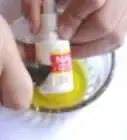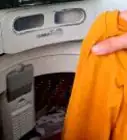This article was co-authored by Michelle Driscoll, MPH and by wikiHow staff writer, Dan Hickey. Michelle Driscoll is the Owner of Mulberry Maids, which is based in Fort Collins, Colorado. With five years of experience, her business specializes in cleaning homes and small offices. She holds a Masters in Public Health from the Colorado School of Public Health. Additionally, Mulberry Maids has an A+ rating from the Better Business Bureau.
There are 10 references cited in this article, which can be found at the bottom of the page.
wikiHow marks an article as reader-approved once it receives enough positive feedback. This article received 32 testimonials and 100% of readers who voted found it helpful, earning it our reader-approved status.
This article has been viewed 5,629,706 times.
There’s no better feeling than when a sticker peels off of something in one piece and leaves no sticky mess behind. However, peeling a sticker isn’t always so satisfying. If you’re left with a mess of sticky residue, don’t worry—there are a ton of different ways to clean it up, and you probably already have the supplies you need in your pantry or cleaning cabinet. In this article, we’ll show you the best ways to remove sticker residue from any surface in your home with common household products. The chances of that residue sticking around are gone!
Things You Should Know
- Remove as much residue as you can mechanically with a plastic scraper, packing tape, or a hair dryer before trying household or chemical cleaners.
- Use soapy water, vinegar, cooking oil, or even peanut butter or mayo to saturate the adhesive, then wipe the spot clean with a cloth or paper towel.
- Try acetone, rubbing alcohol, WD-40, or commercial cleaners on extra stubborn residue spots.
- Use oily cleaning products on non-porous surfaces only, and keep acidic or corrosive cleaners like vinegar away from stone and metals.
Steps
Expert Q&A
-
QuestionHow do you remove sticker residue from books?
 Michelle Driscoll, MPHMichelle Driscoll is the Owner of Mulberry Maids, which is based in Fort Collins, Colorado. With five years of experience, her business specializes in cleaning homes and small offices. She holds a Masters in Public Health from the Colorado School of Public Health. Additionally, Mulberry Maids has an A+ rating from the Better Business Bureau.
Michelle Driscoll, MPHMichelle Driscoll is the Owner of Mulberry Maids, which is based in Fort Collins, Colorado. With five years of experience, her business specializes in cleaning homes and small offices. She holds a Masters in Public Health from the Colorado School of Public Health. Additionally, Mulberry Maids has an A+ rating from the Better Business Bureau.
Founder, Mulberry Maids Depending on where the residue is on the book, you probably want to start out with the gentlest option possible. Try to lightly scrub with warm soapy water, and add in some vinegar if more power is needed. Rubbing alcohol can also be used. It would probably be best to stay away from really strong chemicals like the commercial adhesive remover Goo-Gone or acetone.
Depending on where the residue is on the book, you probably want to start out with the gentlest option possible. Try to lightly scrub with warm soapy water, and add in some vinegar if more power is needed. Rubbing alcohol can also be used. It would probably be best to stay away from really strong chemicals like the commercial adhesive remover Goo-Gone or acetone. -
QuestionHow do I get sticker residue off plastic?
 Michelle Driscoll, MPHMichelle Driscoll is the Owner of Mulberry Maids, which is based in Fort Collins, Colorado. With five years of experience, her business specializes in cleaning homes and small offices. She holds a Masters in Public Health from the Colorado School of Public Health. Additionally, Mulberry Maids has an A+ rating from the Better Business Bureau.
Michelle Driscoll, MPHMichelle Driscoll is the Owner of Mulberry Maids, which is based in Fort Collins, Colorado. With five years of experience, her business specializes in cleaning homes and small offices. She holds a Masters in Public Health from the Colorado School of Public Health. Additionally, Mulberry Maids has an A+ rating from the Better Business Bureau.
Founder, Mulberry Maids There are many methods to try to remove sticker residue on plastic. A safe and all-natural way to start with is to mix vinegar and soapy water and submerge the plastic in the mix if possible. Let it sit for 30 minutes, then rub and scrub away the residue. You can apply more vinegar or solution mixture if there is still residue left over. Other ways include using rubbing alcohol, cooking oil, or peanut butter.
There are many methods to try to remove sticker residue on plastic. A safe and all-natural way to start with is to mix vinegar and soapy water and submerge the plastic in the mix if possible. Let it sit for 30 minutes, then rub and scrub away the residue. You can apply more vinegar or solution mixture if there is still residue left over. Other ways include using rubbing alcohol, cooking oil, or peanut butter. -
QuestionHow can I remove sticker residue from a white board?
 Michelle Driscoll, MPHMichelle Driscoll is the Owner of Mulberry Maids, which is based in Fort Collins, Colorado. With five years of experience, her business specializes in cleaning homes and small offices. She holds a Masters in Public Health from the Colorado School of Public Health. Additionally, Mulberry Maids has an A+ rating from the Better Business Bureau.
Michelle Driscoll, MPHMichelle Driscoll is the Owner of Mulberry Maids, which is based in Fort Collins, Colorado. With five years of experience, her business specializes in cleaning homes and small offices. She holds a Masters in Public Health from the Colorado School of Public Health. Additionally, Mulberry Maids has an A+ rating from the Better Business Bureau.
Founder, Mulberry Maids Using a cooking oil spray, an oil and baking soda paste, or a product like Goo Gone should help you remove the sticker residue on your white board.
Using a cooking oil spray, an oil and baking soda paste, or a product like Goo Gone should help you remove the sticker residue on your white board.
Warnings
- Wear disposable gloves if you’re using chemicals like WD-40 or acetone to avoid skin irritation.[16]⧼thumbs_response⧽
- Avoid using oil on porous surfaces, like wood or fabric, and don’t use acidic or corrosive cleaners like vinegar on metals or stone.⧼thumbs_response⧽
References
- ↑ https://www.popularmechanics.com/home/how-to-plans/a25325169/how-to-remove-sticker-residue/
- ↑ https://www.cleanipedia.com/gb/floor-and-surface-cleaning/how-to-remove-sticker-residue.html
- ↑ https://youtu.be/SuSiStmvxXg?t=64
- ↑ https://www.thekitchn.com/best-way-remove-sticky-stickers-23201250
- ↑ https://experthometips.com/how-to-remove-sticker-residue-leave-no-marks
- ↑ https://www.cleanipedia.com/gb/floor-and-surface-cleaning/how-to-remove-sticker-residue.html
- ↑ https://www.reusablenation.com/zero-waste-living/9-different-ways-to-get-sticky-labels-off-glass-jars
- ↑ https://www.thekitchn.com/best-way-remove-sticky-stickers-23201250
- ↑ https://www.thekitchn.com/best-way-remove-sticky-stickers-23201250
- ↑ https://www.thekitchn.com/7-surprising-things-you-can-clean-with-mayo-22932269
- ↑ https://experthometips.com/how-to-remove-sticker-residue-leave-no-marks
- ↑ https://www.tipsbulletin.com/how-to-remove-sticker-residue-from-fabric/
- ↑ https://experthometips.com/how-to-remove-sticker-residue-leave-no-marks
- ↑ https://www.thekitchn.com/best-way-remove-sticky-stickers-23201250
- ↑ https://www.homeaglow.com/hub/cleaning-tips/how-to-get-sticker-residue-off-glass
- ↑ https://sciencing.com/gloves-should-used-acetone-8536346.html
About This Article
To remove stubborn sticker residue, first peel off as much of the residue as you can with your fingers. Then, try using a plastic knife or the edge of a credit card to scrape the rest of the residue off. You can also scrub the residue off using the rough side of a sponge or rub it away with a pencil eraser. Soaking the item in hot, soapy water first will help loosen the adhesive and make the sticker residue easier to remove. Or, you can use a hairdryer to loosen the adhesive. Another option is applying a solvent to soften the sticker residue, like rubbing alcohol, vodka, WD-40, olive oil, or vinegar. Let the solvent sit for a few minutes, then scrape away the residue using your fingers or another tool. For more tips, like when to use vodka, peanut butter, or even mayonnaise, read on!


